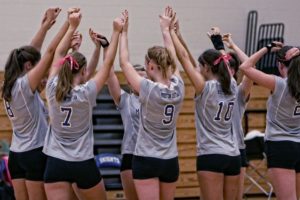Physical activity and sports play a crucial role in the holistic development of children, and volleyball offers a fantastic avenue for young athletes to improve their coordination, teamwork, and motor skills.

For 3rd graders, it is essential to introduce age-appropriate drills that cater to their abilities and keep them engaged.
These drills help develop basic volleyball skills and foster a love for the sport.
This article will explore a range of fun and effective volleyball drills specifically designed for 3rd graders.
From balloon volleyball to target serving, these drills focus on improving hand-eye coordination, passing accuracy, spiking technique, and more.
By incorporating these drills into training sessions, coaches, parents, and teachers can create a positive and rewarding experience that sets the foundation for a lifelong passion for volleyball.
Drill 1: Balloon Volleyball
Balloon volleyball is an excellent introductory drill that allows 3rd graders to grasp the basic concepts of hitting and serving in a fun and less intimidating manner.
By substituting a traditional volleyball with a balloon, players can focus on developing hand-eye coordination and fundamental skills without fearing hard hits or injuries.
Instructions
Divide the players into two teams, create a makeshift net, or mark a boundary on the floor using tape.
The objective is to keep the balloon off the ground and pass it back and forth over the “net” using only their hands or forearms.
Encourage players to use proper techniques, such as cupping their hands or making a platform with their forearms, to control and direct the balloon.
Drill 2: Partner Passing
Partner passing is a foundational drill that emphasizes hand-eye coordination and passing accuracy.
By working in pairs, 3rd graders can develop basic skills while building trust and communication with their teammates.
Instructions
Pair up the players and have them stand facing each other at a short distance, roughly a few feet apart.
Each player should extend their arms in front of them, ready to receive and pass the ball. Start using a lightweight volleyball or soft foam ball for added safety.
Encourage the players to pass the ball back and forth using their hands.
Emphasize the importance of using proper techniques, such as forming a diamond shape with their thumbs and forefingers to create a target for the ball.
Remind them to focus on accuracy and control while maintaining a steady rhythm.
As players become more comfortable, you can gradually increase the distance between partners or introduce variations like adding movement or using different passing techniques, such as forearm passing.
Drill 3: Bump Circle
The bump circle drill enhances bumping skills and fosters teamwork among 3rd graders.
This drill focuses on improving players’ ability to accurately and efficiently use their forearms to pass the ball.
Instructions
Form a circle with the players, standing at an arm’s length apart from each other.
The first player starts by bumping the ball to the player next to them, who then bumps it to the next player in the circle.
The objective is to keep the ball moving around the circle without letting it touch the ground.
Encourage players to use the correct forearm passing technique, with their wrists locked and arms forming a platform.
Emphasize the importance of communication and teamwork to ensure smooth ball movement.
Players can challenge themselves by increasing the pace or introducing variations like changing the direction of the ball’s movement.
Drill 4: Target Serving

Target serving is a drill that focuses on developing serving accuracy and control.
By aiming at specific targets, 3rd graders can enhance their serving technique and learn to place the ball precisely.
Instructions
Set up targets on the opposite side of the net, either on the ground or attached to the net itself.
These targets can be small cones, hula hoops, or any other easily visible markers. Each player takes turns serving the ball, aiming to hit the targets.
Encourage players to focus on their serving technique, such as a consistent toss and proper arm swing.
Remind them to aim for different targets to challenge themselves. Provide feedback and guidance on their serving form, ensuring they develop accuracy and control.
Drill 5: Four-Square Volleyball
Four-Square Volleyball is a dynamic drill combining traditional volleyball elements and the popular four-square game.
This drill promotes teamwork and enhances quick reflexes and strategic thinking among 3rd graders.
Instructions
Divide the volleyball court into four squares using boundary lines or markers. Assign one player to each square.
The ball is served into one of the squares, and teams must work together to keep it within their square while trying to move it into another.
Players can only hit the ball once before passing it to another square.
Encourage players to communicate and strategize with their teammates to outmaneuver the opponents and score points by successfully moving the ball to other squares.
Drill 6: Zig-Zag Spike
The Zig-Zag Spike drill focuses on developing spiking technique and footwork, crucial skills for attacking the ball effectively.
Players can practice spiking by incorporating a zig-zag path while improving their agility and body control.
Instructions
Create a zig-zag path using cones or markers on the court. The path should consist of alternating diagonal lines.
Assign specific spots along the path where players will practice their spikes.
Players take turns running through the zig-zag path, approaching the designated spots and executing spike techniques at each location.
Encourage players to focus on footwork, arm swing, and timing while maintaining control over the spike.
Provide feedback and guidance on their technique, ensuring they maintain proper form throughout the drill.
Encourage players to challenge themselves by increasing the speed or complexity of the zig-zag path as they become more proficient.
Drill 7: Cooperative Ball Toss

The Cooperative Ball Toss drill is designed to improve communication and teamwork skills among 3rd graders.
By working together to keep the ball in constant motion, players learn the importance of cooperation and develop trust in their teammates.
Instructions
Have players form a circle, standing at an equal distance from each other.
The players begin by tossing the ball to each other using both hands, ensuring a controlled and accurate toss.
The goal is to maintain a smooth and continuous ball movement without letting it touch the ground.
Encourage players to communicate, call out each other’s names, and adjust their positioning to make successful catches and tosses.
Emphasize the importance of working together as a team and being attentive to each other’s movements.
To increase the challenge, players can incorporate variations such as using only one hand or introducing specific patterns for the ball movement.
Drill 8: Relay Race
The Relay Race drill adds an element of competition while enhancing agility, speed, and hand-eye coordination among 3rd graders.
This fast-paced drill challenges players to pass the ball accurately and quickly as they strive to complete the relay race.
Instructions
Divide the players into teams and set up relay stations on each side of the net. Each team forms a line behind their respective stations.
The first player from each team starts with the ball.
On the signal, the first player serves the ball over the net to the next player in line on their team.
The ball must be passed accurately, ensuring it reaches the next player without touching the ground.
The receiving player then continues the relay by passing the ball to the next player, and so on, until the last player in line successfully passes the ball over the net to complete the race.
Emphasize the importance of speed, accuracy, and maintaining control during the drill.
Encourage players to communicate and strategize to minimize errors and complete the race in the shortest time possible.
Conclusion
These drills improve hand-eye coordination, passing accuracy, spiking technique, teamwork, communication, and court awareness.
By incorporating these age-appropriate and engaging drills into training sessions, coaches, parents, and teachers can help 3rd graders build a solid foundation in volleyball while fostering a positive and enjoyable environment.
Furthermore, these drills instill important life skills such as teamwork, communication, and perseverance, which extend beyond the volleyball court.
As 3rd graders continue their volleyball journey, these skills will serve as a strong foundation for their growth as athletes and individuals.

When I was in high school, I was the best at running. Running for me is not a trend, this is my whole life. I jog every morning, without exceptions: I don’t skip mornings on vacations or business trips. My friends are also sports fans: I went to my best friend’s yoga class for the first time about three years ago.
Since then, I’ve been practicing regularly, and we have also made several yoga trips to India. For my last birthday, I got a skateboard as a present from her. Now we’re both taking personal classes with a coach, and it’s 100% fun!





